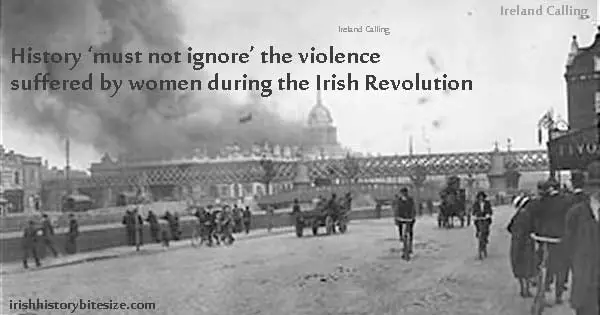Sexual assault, headshaving at gunpoint – the violence suffered by women during the War of Independence and Civil War must not be ignored by history.
That is the view of leading Maynooth professor Linda Connolly who has written a paper arguing that history may have underestimated the number of sexual assaults and violent attacks on women in Ireland between 1917 and 1923.

One story that featured in the paper was that of Cork woman Norah Healy. She was heavily pregnant when she was sexually assaulting by Black and Tans in her home.
Connolly has studied a “very personal letter” written by Healy that described the ordeal.
Healy wrote that she visited the barracks to complain and saw one of the perpetrators there.
“She said it to one of the main officers in charge and he told her ‘oh don’t worry about that’. It never went any further” Connolly said.
Another letter written by a woman in the Midlands described her horrendous ordeal after members of the IRA looted the home she shared with her elderly relatives. She was raped and fell pregnant, before giving up the baby for adoption.
Connolly said: “In the Irish context, it was always presumed that during the War of Independence there was a low level of rape as part of the conflict. I’m not arguing that there were thousands of rapes happening, but this previous assertion of little or no rape does need to be approached with caution because we actually don’t know.
“No different from today, rape is always under reported and it was even more so during that period. Women were not going to come forward for fear of rejection by their husbands, their families and their communities. For some who did come forward, there was no prosecution.
“So it was highly unlikely women who were raped would have come forward. These stories are not going to show up in official statistics for crimes during that period. They’ll show up in archives, where you’ll see children were given up for adoption, or in letters, it’s hidden away.”
Connolly also says that there is hard evidence of women having their hair shaved off as a form of punishment during the conflicts.
One victim was named Eileen Barker. She had her head shaved at gunpoint by members of the IRA for allowing British troops to stay in her hotel.
Connolly explained: “It has been seen as one of the more lenient form of punishments, but it is a highly sexualised thing to cut a woman’s hair off. It was about sexuality, a way of controlling a woman who might have been ‘fraternising’.
“What is interesting about Irish history is that enforced cutting of hair in the dehumanisation and sanctioning of women occurred on both sides of the conflict – Crown forces and IRA – in the period of revolution, an aspect that seems to fall into the bracket of Irish historical amnesia.
“Historians have also examined how women also had to endure being present during physical assaults, including fatal ones, against their close male relatives – but very little work has been done on how violence against women was witnessed by other women.
“Did women escape the worst of the brutalities between 1919-21? I would say no, we cannot presume this and in fact I would go so far as to say they did not. Much more work remains to be done before we can conclude this.”